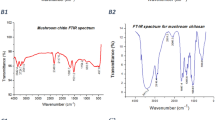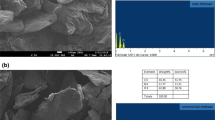Abstract
Chitin is the most important natural polysaccharide after cellulose; however, it is not widely used for industrial application because of its insolubility in many solvents. The present study utilizes Indian major carps (Labeo rohita, Catla catla, and Cirrhinus mrigala) scale to extract chitin and prepare chitosan by a sequence of chemical processes involving demineralization, deproteinization, and deacetylation. The extracted chitosan is characterized by different analytical techniques viz. UV-Vis spectroscopy, FT-IR, TGA, and XRD, and SEM analysis reveals that fish scale waste are good source of chitosan. Compositional analysis of fish scale waste was done by standard methods which reveal that the extracted chitosan was having 0.691% moisture content, 0.53% ash, 109% fat-binding assay (FBC), 104% water-binding assay (WBC) indicating the value depend upon the source of origin and optimization of chemical process of extraction. The antibacterial activity of chitosan against Aeromonas hydrophila, Staphylococcus aureus, Escherichia coli, and Pseudomonas aeruginosa was evaluated by agar well diffusion method. The chitosan also exhibited DPPH scavenging along with anti-inflammatory and anticoagulant activity in a dose-dependent manner. The extracted chitosan also demonstrated preservation and seed germination activities. The result of the present study strongly supports the use of chitosan in pharmaceutical, food industry, and agro-based industries.





Similar content being viewed by others
Data availability
Not applicable
References
Allison PG, Rodriguez RI, Moser RD, Williams BA, Poda AR, Seiter JM, Chandler MQ (2014) Characterization of multi-layered fish scales (Atractosteus spatula) using nanoindentation, X-ray CT, FTIR, and SEM. J Vis Exp 89:e51535
Al-Tawaha ARM, Al-Ghzawi ALA (2013) Effect of chitosan coating on seed germination and salt tolerance of lentil (Lens culinaris L.). Res Crops 14:489–491
Andrade S, Ladchumananandasivam R, Rocha B, Belarmino D, Galvao A (2012) The use of exoskeletons of shrimp (Litopenaeus vanammei) and crab (Ucides cordatus) for the extraction of chitosan and production of nanomembrane. Enzyme Microb Tech 3:495–508
Chung YC, Kuo CL, Chen CC (2005) Preparation and important functional properties of water-soluble chitosan produced through Maillard reaction. Bioresour Technol 96:1473–1482
Das SK, Samantaray D, Mahapatra A, Pal N, Munda R, Thatoi HN (2018) Pharmacological activities of leaf and bark extracts of a medicinal mangrove plant Avicennia officinalis L. Clin Phytosci 4:13. https://doi.org/10.1186/s40816-018-0072-0
Di Martino A, Sittinger M, Risbud MV (2005) Chitosan: a versatile biopolymer for orthopaedic tissue engineering. Biomaterials 26:5983–5990
Gokulalakshmi E, Ramalingam K, Umasankari VMC (2017) Extraction and characterization of chitosan obtained from scales of Clarias gariepinus (catfish). Biotechnol J Int 18:1–8
Helrich K (1990) Official methods of analysis of the association of official analytical chemists. 15th ed. Virginia, USA
Islam MS, Khan S, Tanaka M (2004) Waste loading in shrimp and fish processing effluents: potential source of hazards to the coastal and near shore environments. Mar Pollut Bull 49:103–110
Jeyaraman M, Vignesh R, Sumathi N (2017) Extraction, characterization and applications of chitosan from fish scales. Int J Mod Trends Eng Res 4:137–141
Kaya M, Seyyar O, Baran T, Türkeş T (2014) Bat guano as new and attractive chitin and chitosan source. Front Zool 11:59. https://doi.org/10.1186/s12983-014-0059-8
Knorr D (1982) Functional properties of chitin and chitosan. J Food Sci 47:593–595
Krajewska B (2004) Application of chitin- and chitosan-based materials for enzyme immobilizations: a review. Enzyme Microb Technol 35:126–139
Kumari S, Rath P (2014) Extraction and characterization of chitin and chitosan from (Labeo rohita) fish scales. Procedia Mater Sci 6:482–489
Kumari S, Rath P, Kumar ASH (2016) Chitosan from shrimp shell (Crangon crangon) and fish scales (Labeo rohita): extraction and characterization. Afr J Biotechnol 15:1258–1268
Li R, He J, Xie H, Wang W, Bose SK, Sun Y, Hu J, Yin H (2019) Effects of chitosan nanoparticles on seed germination and seedling growth of wheat (Triticum aestivum L.). Int J Biol Macromol 126:91–100
Mohanasrinivasan V, Mishra M, Paliwal JS, Singh K, Selvarajan E, Suganthi V, Devi CS (2013) Studies on heavy metal removal efficiency and antibacterial activity of chitosan prepared from shrimp shell waste. 3 Biotech 4:167–175
Murugan R, Parimelazhagan T (2014) Comparative evaluation of different extraction methods for antioxidant and anti-inflammatory properties from Osbeckiaparvi folia Arn.–an in vitro approach. J King Saud Univ Sci 26:267–275
Nising P (2006) High-temperature radical polymerization of methyl methacrylate in a continuous pilot scale process [Ph.D. Thesis]. Ecole Polytechnique Federale De Lausanne Lausanne: EPFL
No HK, Meyers SP (1992) Utilization of crawfish processing waste as carotenoids, chitin and chitosan sources. J Korean Soc Food Nutr 21:319–326
Panith N, Wichaphon J, Lertsiri S, Niamsiri N (2016) Effect of physical and physicochemical characteristics of chitosan on fat-binding capacities under in vitro gastrointestinal conditions. LWT-Food Sci Technol 71:25–32
Paul S, Jayan A, Sasikumar CS, Cherian SM (2014) Extraction and purification of chitosan from chitin isolated from sea prawn Fenneropenaeus indicus. Asian J Pharm Clin Res 7:201–204
Qin C, Li H, Xiao Q, Liu Y, Zhu J, Du Y (2006) Water-solubility of chitosan and its antimicrobial activity. Carbohydr Polym 63:367–374
Rajalakshmi A, Narayanaswamy K, Jayachitra A (2013) Antioxidant activity of the chitosan extracted from shrimp exoskeleton. Middle East J Sci 16:1446–1451
Suman TY, Rajasree SR, Ramkumar R, Rajthilak C, Perumal P (2013) The green synthesis of gold nanoparticles using an aqueous root extract of Morinda citrifolia L. Spectrochim Acta A 118C:11–16
Tarafdar A, Biswas G (2013) Extraction of chitosan from prawn shell wastes and examination of its viable commercial applications. Int J Theor Appl Res Mech Engg 2:2319–3182
Trung TS, Bao HND (2015) Physicochemical Properties and antioxidant activity of chitin and chitosan prepared from pacific white shrimp waste. Int J Carbohydr Chem, pp 1–6. https://doi.org/10.1155/2015/706259
Walke S, Srivastava GK, Nikalje MD, Doshi JB, Kumar R, Ravetkar SD, Doshi PJ (2014) Physicochemical and functional characterization of chitosan prepared from shrimp shells and investigation of its antibacterial, antioxidant and tetanus toxoid entrapment efficiency. Int J Pharm Sci Rev Res 26:215–225
Wang JC, Kinsella JE (1976) Functional properties of novel proteins: alfalfa leaf protein. J Food Sci 41:286–292
Zaku SG, Emmanuel SA, Aguzue OC, Thomas SA (2011) Extraction and characterization of chitin; a functional biopolymer obtained from scales of common carp fish (Cyprinus carpio l.): a lesser known source. Afr J Food Sci 5(8):478–483
Consent for publication
The authors gave their consent for publication of the research work.
Author information
Authors and Affiliations
Corresponding author
Ethics declarations
Conflict of interest/Competing interests
The authors declare that they have no conflict of interest.
Ethics approval
Not applicable
Consent to participate
The authors gave their consent to participate in the research work.
Code availability
Not applicable
Additional information
Publisher’s note
Springer Nature remains neutral with regard to jurisdictional claims in published maps and institutional affiliations.
Rights and permissions
About this article
Cite this article
Satpathy, A.A., Dash, S., Das, S.K. et al. Functional and bioactive properties of chitosan from Indian major carp scale. Aquacult Int 29, 417–430 (2021). https://doi.org/10.1007/s10499-020-00622-0
Received:
Accepted:
Published:
Issue Date:
DOI: https://doi.org/10.1007/s10499-020-00622-0




